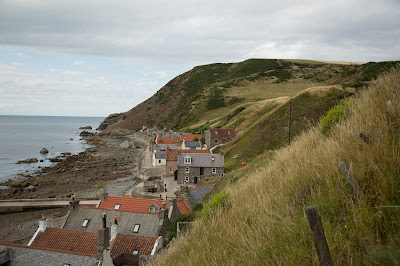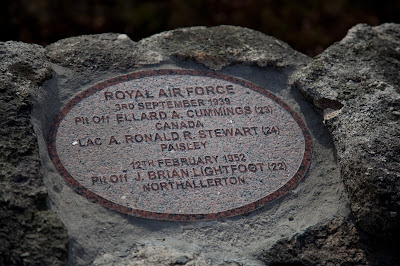Spies and Saboteurs
During the early
years of WW2, spies and saboteurs were put ashore all around the UK coastline,
often by flying boat and sometimes from submarines.
Usually they were quickly picked up by police suspicious of forged documents and in at least one case due to cycling along on the wrong side of the road.
Spies making landfall on the Aberdeenshire coastline had a particularly difficult time of it since, due to the close-knit nature of the coastal communities, any stranger instantly came under special scrutiny.
During April 1941, two armed men landed at Crovie pier from a rubber dinghy. Road signs in the North-east had been removed and the Emergency Coastal Defences were in place. General Ironside’s nearby Innes Links Coastal Gun Battery was yet to fire a shot in anger, but the general mood was fear of invasion from German held Norway and deep distrust of German sounding foreigners.
It was just before 6 a.m. on April 8th, and three hours earlier the two men had been dropped off a few miles offshore from a German flying boat. While climbing into their rubber dinghy, they had lost some of their equipment when the Luftwaffe aircrew, fearful of being caught on the surface by allied air patrols, panicked and threw the men’s bicycles into the North Sea where no doubt they lie to this day.
As they watched the seaplane take off for the return trip to Norway, the pair must have wondered what on earth had possessed them to volunteer as German spies and what fate would await them when they made landfall.
The two were in fact Norwegian. John Helge Moe and Tor Glad had been recruited by the German security services to report on the Moray coastal defences and carry out acts of sabotage on the Scottish mainland.
On disembarking at Crovie pier the would be spies seemingly knocked on the door of a local man and asked him in broken English how to get to Banff by bus. Very few locals spoke a foreign language and despite a recent influx of Italian Prisoners of War and Polish servicemen into the area the householder became suspicious and in due course the two men came to the attention of the local police.
The luckless spies were promptly arrested and interrogated at Banff Police Station before being turned and used as double agents against their German masters. One later joined the Norwegian Army in Exile while the second Norwegian lived out the remainder of the war in an internment camp.
In an effort to fool the German handlers and fend off suspicion that Mutt and Jeff might have changed sides, MI5 apparently arranged fake sabotage operations which were then reported as the work of the pair. One such operation ended in farce when MI5 operatives were caught planting dummy incendiaries at a Ministry of Food flour warehouse in Wealdstone. The investigation into this fake act of sabotage was quietly dropped by Scotland Yard but the plan had the desired effect since the incident was widely reported in the British press.
Usually they were quickly picked up by police suspicious of forged documents and in at least one case due to cycling along on the wrong side of the road.
Spies making landfall on the Aberdeenshire coastline had a particularly difficult time of it since, due to the close-knit nature of the coastal communities, any stranger instantly came under special scrutiny.
During April 1941, two armed men landed at Crovie pier from a rubber dinghy. Road signs in the North-east had been removed and the Emergency Coastal Defences were in place. General Ironside’s nearby Innes Links Coastal Gun Battery was yet to fire a shot in anger, but the general mood was fear of invasion from German held Norway and deep distrust of German sounding foreigners.
It was just before 6 a.m. on April 8th, and three hours earlier the two men had been dropped off a few miles offshore from a German flying boat. While climbing into their rubber dinghy, they had lost some of their equipment when the Luftwaffe aircrew, fearful of being caught on the surface by allied air patrols, panicked and threw the men’s bicycles into the North Sea where no doubt they lie to this day.
As they watched the seaplane take off for the return trip to Norway, the pair must have wondered what on earth had possessed them to volunteer as German spies and what fate would await them when they made landfall.
The two were in fact Norwegian. John Helge Moe and Tor Glad had been recruited by the German security services to report on the Moray coastal defences and carry out acts of sabotage on the Scottish mainland.
On disembarking at Crovie pier the would be spies seemingly knocked on the door of a local man and asked him in broken English how to get to Banff by bus. Very few locals spoke a foreign language and despite a recent influx of Italian Prisoners of War and Polish servicemen into the area the householder became suspicious and in due course the two men came to the attention of the local police.
The luckless spies were promptly arrested and interrogated at Banff Police Station before being turned and used as double agents against their German masters. One later joined the Norwegian Army in Exile while the second Norwegian lived out the remainder of the war in an internment camp.
In an effort to fool the German handlers and fend off suspicion that Mutt and Jeff might have changed sides, MI5 apparently arranged fake sabotage operations which were then reported as the work of the pair. One such operation ended in farce when MI5 operatives were caught planting dummy incendiaries at a Ministry of Food flour warehouse in Wealdstone. The investigation into this fake act of sabotage was quietly dropped by Scotland Yard but the plan had the desired effect since the incident was widely reported in the British press.
There are more such
tales @: ‘The A-Z of Curious Aberdeenshire’ and even more in my ‘The Little
History of Aberdeenshire’ – due out next March. Bring it on.











Comments
Post a Comment